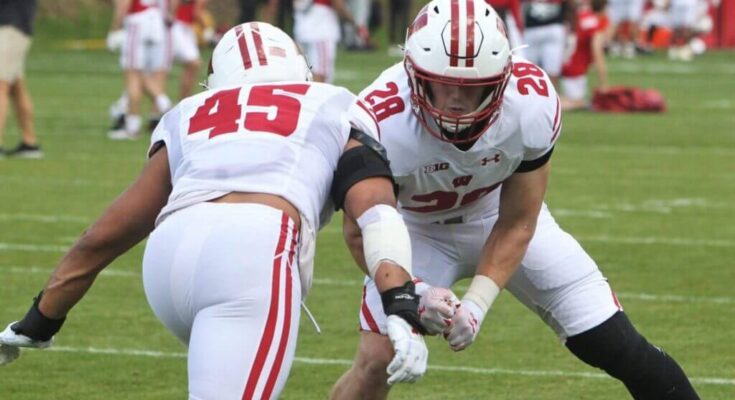“Chaos or Clarity? Wisconsin’s Defense Faces Stunning Shake-Up After Nyzier Fourqurean Ruling—and the New Depth Chart Will Shock You”
The news that Nyzier Fourqurean will be sidelined due to an eligibility ruling sent shockwaves through Madison and the wider Wisconsin football community. Few anticipated a roster twist this late in the offseason, especially one involving a defensive piece projected to play a critical role in the Badgers’ secondary. But now that the decision is final, the coaching staff has no choice but to pivot and recalibrate. The ripple effect touches not only the safety room but the entire defensive architecture, and as the dust settles, a clearer—though still evolving—picture of the new depth chart emerges. And make no mistake: this adjustment is not just a name swap; it’s a fundamental reshaping of roles, rotations, and responsibilities ahead of a season where Wisconsin cannot afford defensive instability in a reloaded Big Ten.
Fourqurean’s absence matters because of versatility. At 6-foot-1 and over 200 pounds, he was the prototype hybrid safety that Wisconsin’s scheme thrives on—a player comfortable dropping into the box, covering tight ends in man, or patrolling deep thirds in disguised coverage shells. He had range, football IQ, and, most importantly, trust from the staff. Removing that piece is like taking the queen off a chessboard: you still have moves, but the geometry changes. Suddenly, matchups that felt favorable now require creative answers. Defensive coordinator Mike Tressel has been here before—navigating attrition, tweaking alignments—but the challenge now isn’t just plugging a hole. It’s about maintaining schematic integrity while giving emerging players confidence to execute under live fire.
The first domino to fall involves the safety duo. Before the ruling, the expectation was a pairing of Fourqurean and Hunter Wohler anchoring the back end, with Wohler as the hammer in run fits and Fourqurean handling more coverage-heavy assignments. That balance allowed Wisconsin to spin the safeties post-snap, bluff pressures without hemorrhaging seams, and maintain flexibility against both power and tempo offenses. Without Fourqurean, Wohler’s role tilts toward the deep middle more often, reducing his availability as an alley enforcer. That means someone else must become the “down” presence—likely Travian Blaylock or Austin Brown. Blaylock brings experience but not Fourqurean’s length; Brown has athletic upside but still flashes occasional hesitation in key reads. Whoever claims the spot will dictate whether Wisconsin can sustain its pressure packages or must simplify to limit coverage busts.
Corners feel the shock indirectly. Fourqurean’s ability to erase certain vertical threats gave corners license to play aggressive, squeezing windows on slants and digs without fearing the big post shot. Now, Ricardo Hallman and Alexander Smith carry heavier burdens. Expect more split-safety looks early in the year as a hedge against explosive plays, even if it dulls some of the exotic rotations Tressel loves to call. The depth chart’s corner hierarchy remains stable for now, but watch for redshirt freshman Jonas Duclona to siphon snaps in dime packages as Wisconsin leans on speed over pure size in sub-packages.
Linebacker deployment shifts too, though not because of personnel shortages. The loss of a versatile safety compresses the menu of simulated pressures—those clever designs where a safety bluffs blitz then bails while a linebacker inserts late. Without that bluff credibility, linebackers like Christian Alliegro and Tackett Curtis may be asked to carry more of the disguise burden. That’s a lot to ask of guys already tasked with run fits and green-dog triggers, but Curtis in particular has the athleticism to hint at pressure and still recover into coverage. The unintended upside? Expect Curtis’ snap count to spike, accelerating his rise from promising sophomore to defensive centerpiece.
The defensive line? On paper, unaffected. In reality, the margin for error narrows. When coverage confidence dips, pressure must hit faster, and that means James Thompson Jr. and Rodas Johnson owning their one-on-ones. Wisconsin’s front thrived in spurts last year but lacked relentless havoc; this season, they can’t settle for “contain” when the backend needs an assist. The staff could sprinkle in more odd-front looks with a stand-up edge to manufacture rush without fully sacrificing coverage numbers, but that’s threading a needle against Big Ten maulers who weaponize gaps if you cheat the box.
Here’s the under-discussed layer: communication. Losing Fourqurean isn’t just about physical traits; it strips away a vocal signaler who aligned bodies in tempo scenarios. That job now defaults to Wohler, whose plate was already heavy. Can he own that and still play free? If not, expect growing pains in September—misaligned coverages, burned timeouts, late substitutions. Those mistakes flip games in a league where margins are already knife-thin.
Spring tape offers clues about contingencies. Blaylock logged heavy reps with the ones during multiple install periods and looked serviceable in pattern-matching concepts, though occasional late triggers on crack-replace duty showed up. Brown’s high-end athleticism is tempting, especially against spread looks, but his angles in space remain a work-in-progress. A wildcard? Safety-turned-nickel Preston Zachman. His hybrid frame could let Tressel experiment with “big nickel” groupings, covering for inexperience by crowding the box with length and forcing quarterbacks to test tight windows outside.
Fan boards are already buzzing about freshman phenom Braedyn Moore. Could the four-star see meaningful snaps early? Coaches have praised his football IQ, and his spring scrimmage splash plays didn’t hurt the hype. But leaning on a true freshman in high-leverage situations is a gamble—one Wisconsin might take by midseason if depth stress compounds.
The updated depth chart projection, as it stands, feels fluid. Expect Wohler locked at one safety spot, Blaylock penciled opposite him in early downs, Brown rotating in sub-packages, and Zachman sliding into hybrid roles depending on opponent tendencies. Corners remain Hallman and Smith, with Duclona circling as the dime piece. Linebackers? Alliegro and Curtis headline inside, with Maema Njongmeta spelling and rotating situationally. Edges belong to Darryl Peterson and C.J. Goetz for now, though if pass rush sputters, don’t rule out more creative mug looks with Curtis walked up. Up front, Thompson and Johnson flank nose anchor Gio Paez, with Cade McDonald in the rotation.
Does this projection scream “finished product”? Not yet. And that’s the point: the ruling didn’t just shake depth—it triggered an evolution. The 2025 Wisconsin defense you see in September may look nothing like the one in November. In between, expect tinkering: heavier zone early, layered fire zones later, maybe even a safety-late rotation renaissance if Brown matures fast. The coaching staff will earn its paycheck this fall, juggling development with results in a league unforgiving to experiments gone wrong.
There’s irony here. For all the offseason ink spilled on Wisconsin’s offensive makeover, it’s the defense now carrying the most volatile storylines. But volatility isn’t inherently fatal. Sometimes it breeds urgency, and urgency can harden an edge. Insiders say practices since the ruling have crackled with competitiveness—safeties logging extra film hours, linebackers staying late for communication drills, even corners quizzing each other on route distributions. That buy-in matters because scheme tweaks only travel as far as player ownership.
The bigger narrative arc looms: can Wisconsin’s defense absorb this blow and still spearhead a season where playoff chatter isn’t a punchline? It starts with adaptability—coaches willing to bend the blueprint without breaking identity. It continues with leadership—Wohler stamping his voice, Alliegro and Curtis setting tone. And it ends with Saturdays in which opponents stop asking, “Where can we exploit them?” and start wondering, “Where do we even go?”
If that happens, if this recalibrated depth chart holds its shape under stress, the Nyzier Fourqurean ruling will fade from headline to footnote. But make no mistake: in mid-July, it feels seismic because it is. The Badgers lost a chess piece. Whether they win the game now depends on how well they master the new board.


